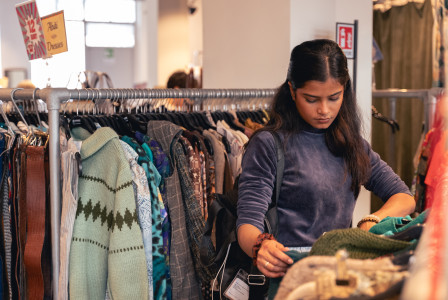Opinions
18 November 2025
Why fast-fashion is harming second-hand – and what we can do about it
Opinions
18 November 2025
Social dimension
Sustainable competitiveness
Regulation and public governance
+4 more
Login / create an account to be able to react
-
2

As the second-hand sector becomes a pillar of circular fashion, it is now at risk—challenged by declining garment quality, market saturation, and pricing pressures. The ripple effects are not only environmental but also socioeconomic, particularly in the Global South.
The following opinion piece first appeared on 04/07/2025 in Fashion United.
About the author: Karina Bolin is Circular Textiles Director, Global North, at Humana People to People, international non-profit organization that has been collecting, sorting, and selling used clothing for over forty years to promote a circular textile economy, create green jobs and reduce environmental impact. Bolin has played a key role in developing efficient second-hand clothing systems, collaborating with municipalities and industry stakeholders to create service models and guidelines for textile circularity. She contributes to European forums on circular economy and helped build international value chains for second-hand textiles.
Humana People to People
Humana People to People
Topics
EU-27
NGOs / Non-profits
-
Transition Pathway's building blocks
-
-
Social dimension
-
Sustainable competitiveness
-
Regulation and public governance
-
-
Industrial ecosystems
-
-
Proximity and social economy
-
Retail
-
Textile
-
-
Textiles ecosystem areas
-
-
Waste management, reuse and repair
-
Share
Why fast-fashion is harming second-hand – and what we can do about it
June ended with yet another blow to Europe’s struggling post-consumer textiles sector: Texaid Germany filed for insolvency. This is a significant setback for the group and for the broader reuse and recycling ecosystem. Just as European policymakers begin to treat textile waste with the seriousness it deserves, the very infrastructure needed to deliver on those ambitions is plunging.
Yet it’s not textile waste itself that concerns me most. According to UNEP’s 2020 report “Sustainability and Circularity in the Textile Value Chain”, the end-of-life phase accounts for less than 1 percent of the environmental impact of the global apparel value chain. 75 percent of impacts happen in the production phase. That’s why keeping clothes in use for as long as possible is not only logical, it’s essential.
But what happens when the system that enables reuse and circularity begins to collapse?
Starting in the 80’s, affluent citizens of the global North were generating a constant wardrobe surplus that was happily donated to charitable organizations. Humana People to People, then an expanding global solidarity movement, identified this opportunity and gradually build its network of second-hand clothing businesses. These generated funds for its social projects, as well as economic opportunity in the global South through the supply of a much-needed commodity: affordable quality clothing.
Today, the second-hand clothing market transcends the poverty arena and is cherished for its sustainability and aesthetic value. Second-hand is where durable meets plenty: I wear your clothes and you wear my clothes and we both have new clothes while nothing has been produced. This beautiful equation requires some degree of repair, care and creative redesign, which are scarce in the global North but are widely practiced in Africa, the world’s largest reuse market.
Along came fast-fashion, in the early 2000’s, and now ultra-fast-fashion hitchhiking on the pandemic. Disruptive manufacturing and logistics lowered costs, and novel marketing techniques spurred consumption – coupled with a 36 percent decrease in average wear time, according to the Ellen McArthur Foundation
Although demand for second-hand clothes has also been growing worldwide (and can grow much more), today the global used textiles market is in crisis. There are circumstantial factors, such as the war in Ukraine (major second-hand destination), rising energy costs and a stagnant economy; but in essence, market conditions have changed structurally.
The average quality of used garments is lower. As costs were cut on raw materials and tailoring, garments fade and loose shape quicker with washing, and their reuse value decreases. According to a recent study by the Dutch Ministry of Environment and Infrastructure, textile sorting centers report a decrease in reuse rates from 80 percent to 50 percent in the last years. Ultra-fast-fashion brands pose an extra challenge: articles cost so little when new that second-hand shops in Europe can barely make a profit on them. As for non-reusable items, recyclers pay little or nothing for these, as there is enough post-industrial textile waste and still good quality post-consumer waste to meet the limited needs of a market that has yet to scale.
There are more used textiles on the market. Clothes are discarded massively in new parts of the world. China saw a 600 percent rise in value of exported second-hand clothes in just 10 years. This is the result of a societal evolution – the emergence of a Chinese middle-class and associated consumption – that will not be undone.
The competitive advantage of second-hand is getting smaller. Price is the main reason for shopping second-hand worldwide. But low-cost new items are tailing closely. Even in Mozambique, one of the world’s poorest countries, fast fashion brands based in South Africa are now the biggest suppliers of the country’s main street shops, as shown in a recent report commissioned by ADPP Mozambique (member of the Federation Humana People to People). Second-hand remains competitive, but if further constraints fall upon global reuse markets, fast fashion will conquer even more territory.
In these conditions, the business of collecting, sorting and selling used textiles cannot be sustained. Operators are going bankrupt. Circular fashion is losing its most valuable ecosystem.
What can be done? First of all, immediately roll out Extended Producer Responsibility. This policy is efficient in gathering funds to cover the cost of waste segregation and stimulate recycling. The post-consumer textiles sector needs to be kept alive. With EPR funds, reuse operators and recyclers can be remunerated, even if the market doesn’t pay enough for the materials they produce.
Demand quality garments through ecodesign requirements. The EU is preparing these within its Ecodesign for Sustainable Products Regulation. Ambition is needed, as well as resolute enforcement to ensure that all products placed on the EU market are compliant.
Apply customs tariffs and VAT to online fast-fashion orders. Global online marketplaces are enabling cheap garments to easily reach European consumers while dodging fiscal obligations and safety controls. It is not fair that those producers who have been greening their supply chain and production processes suddenly face the influx of these goods. Fiscal measures will help balance the market. VAT reduction for circular products and services would further enhance their competitiveness.
Last but not least, target behavior. The French anti fast-fashion law is showing the way: banning advertisement should not be a taboo. The transition will not happen without cultural transformation, and this can be achieved much in the same way that smoking was made unpopular. Anti-tobacco laws imposed high tax and prices, smoke-free public places, large health warnings on products and bans on tobacco advertising. According to the World Health Organization, they yielded results: 32,7 percent of the world population consumed some form of tobacco in 2000; today, it is 19,8 percent.
We have the means to act. The global second-hand clothing industry is an asset – for the environment and for global development – that deserves to be protected and fostered. I say let’s not stop until every wardrobe is composed of 50 percent second-hand. A target both ambitious and chic.
Comments (0)
See also
Welcome to the 'Certification and Communication’ Community workspace
- Categories
- Infrastructure Investments and funding R&I, techniques and technological solutions +26 more
Welcome to the Skills and Talent Community Workspace!
- Categories
- Infrastructure Investments and funding R&I, techniques and technological solutions +28 more
Your summer reading list on textiles and resilient communities
- Categories
- Infrastructure Investments and funding R&I, techniques and technological solutions +20 more




